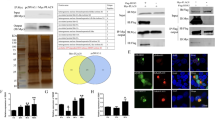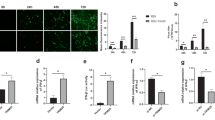Abstract
p17 is a nonstructural protein of avian reovirus (ARV) that induces autophagy in infected cells. In the present study, we investigated the effect of p17 and its nuclear localization signal (NLS) on autophagy and viral replication. When Vero cells and DF1 cells were transfected with mutant p17 in which lysine (K) at position 122 and arginine (R) at position 123 were mutated to alanine (A), the expression level of LC3 II decreased dramatically after transfection. The expression of the polypeptide encompassing the first 103 amino acids of p17, a region that did not contain the NLS, did not have a significant effect on autophagy. Moreover, when cells overexpressing mutant p17 were infected with the ARV GX2010/1 strain, the viral titer was significantly decreased compared with the expression of wild-type p17. In general, the NLS of p17 facilitates the induction of autophagy and is correlated with an increase in virus production.





Similar content being viewed by others
References
Aminev AG, Amineva SP, Palmenberg AC (2003) Encephalomyocarditis viral protein 2A localizes to nucleoli and inhibits cap-dependent mRNA translation. Virus Res 95:45–57
Aminev AG, Amineva SP, Palmenberg AC (2003) Encephalomyocarditis virus (EMCV) proteins 2A and 3BCD localize to nuclei and inhibit cellular mRNA transcription but not rRNA transcription. Virus Res 95:59–73
Amineva SP, Aminev AG, Palmenberg AC, Gern JE (2004) Rhinovirus 3C protease precursors 3CD and 3CD’ localize to the nuclei of infected cells. J Gen Virol 85:2969–2979
Benavente J, Martínez-Costas J (2007) Avian reovirus: structure and biology. Virus Res 123:105–119
Beugnet A, Tee AR, Taylor PM, Proud CG (2003) Regulation of targets of mTOR (mammalian target of rapamycin) signalling by intracellular amino acid availability. The Biochemical journal 372:555–566
Bian J, Wang K, Kong X, Liu H, Chen F, Hu M, Zhang X, Jiao X, Ge B, Wu Y, Meng S (2011) Caspase- and p38-MAPK-dependent induction of apoptosis in A549 lung cancer cells by Newcastle disease virus. Arch Virol 156:1335–1344
Bodelon G, Labrada L, Martinez-Costas J, Benavente J (2001) The avian reovirus genome segment S1 is a functionally tricistronic gene that expresses one structural and two nonstructural proteins in infected cells. Virology 290:181–191
Cao S, Liu X, Yu M, Li J, Jia X, Bi Y, Sun L, Gao GF, Liu W (2012) A nuclear export signal in the matrix protein of Influenza A virus is required for efficient virus replication. J Virol 86:4883–4891
Castedo M, Ferri KF, Kroemer G (2002) Mammalian target of rapamycin (mTOR): pro- and anti-apoptotic. Cell Death Differ 9:99–100
Chi PI, Huang WR, Lai IH, Cheng CY, Liu HJ (2013) The p17 nonstructural protein of avian reovirus triggers autophagy enhancing virus replication via activation of phosphatase and tensin deleted on chromosome 10 (PTEN) and AMP-activated protein kinase (AMPK), as well as dsRNA-dependent protein kinase (PKR)/eIF2alpha signaling pathways. J Biol Chem 288:3571–3584
Codogno P, Meijer AJ (2006) Atg5: more than an autophagy factor. Nat Cell Biol 8:1045–1047
Costas C, Martinez-Costas J, Bodelon G, Benavente J (2005) The second open reading frame of the avian reovirus S1 gene encodes a transcription-dependent and CRM1-independent nucleocytoplasmic shuttling protein. J Virol 79:2141–2150
Duan Z, Song Q, Wang Y, He L, Chen J, Zhu Y, Hu S, Liu X (2013) Characterization of signal sequences determining the nuclear export of Newcastle disease virus matrix protein. Arch Virol 158:2589–2595
Duan Z, Li J, Zhu J, Chen J, Xu H, Wang Y, Liu H, Hu S, Liu X (2014) A single amino acid mutation, R42A, in the Newcastle disease virus matrix protein abrogates its nuclear localization and attenuates viral replication and pathogenicity. J Gen Virol 95:1067–1073
Fullgrabe J, Lynch-Day MA, Heldring N, Li W, Struijk RB, Ma Q, Hermanson O, Rosenfeld MG, Klionsky DJ, Joseph B (2013) The histone H4 lysine 16 acetyltransferase hMOF regulates the outcome of autophagy. Nature 500:468–471
Hiscox JA (2003) The interaction of animal cytoplasmic RNA viruses with the nucleus to facilitate replication. Virus Res 95:13–22
Kabeya Y, Mizushima N, Ueno T, Yamamoto A, Kirisako T, Noda T, Kominami E, Ohsumi Y, Yoshimori T (2000) LC3, a mammalian homologue of yeast Apg8p, is localized in autophagosome membranes after processing. EMBO J 19:5720–5728
Levine B, Kroemer G (2008) Autophagy in the pathogenesis of disease. Cell 132:27–42
Lidsky PV, Hato S, Bardina MV, Aminev AG, Palmenberg AC, Sheval EV, Polyakov VY, van Kuppeveld FJ, Agol VI (2006) Nucleocytoplasmic traffic disorder induced by cardioviruses. J Virol 80:2705–2717
Liu HJ, Lin PY, Lee JW, Hsu HY, Shih WL (2005) Retardation of cell growth by avian reovirus p17 through the activation of p53 pathway. Biochem Biophys Res Commun 336:709–715
Meng S, Jiang K, Zhang X, Zhang M, Zhou Z, Hu M, Yang R, Sun C, Wu Y (2012) Avian reovirus triggers autophagy in primary chicken fibroblast cells and Vero cells to promote virus production. Arch Virol 157:661–668
Peeples ME, Wang C, Gupta KC, Coleman N (1992) Nuclear entry and nucleolar localization of the Newcastle disease virus (NDV) matrix protein occur early in infection and do not require other NDV proteins. J Virol 66:3263–3269
Petiot A, Pattingre S, Arico S, Meley D, Codogno P (2002) Diversity of signaling controls of macroautophagy in mammalian cells. Cell Struct Funct 27:431–441
Phillips GJ (2001) Green fluorescent protein—a bright idea for the study of bacterial protein localization. FEMS Microbiol Lett 204:9–18
Rajamaki ML, Valkonen JP (2009) Control of nuclear and nucleolar localization of nuclear inclusion protein a of picorna-like Potato virus A in Nicotiana species. Plant Cell 21:2485–2502
Rizzuto R, Brini M, Pizzo P, Murgia M, Pozzan T (1995) Chimeric green fluorescent protein as a tool for visualizing subcellular organelles in living cells. Curr Biol 5:635–642
Salvetti A, Greco A (2014) Viruses and the nucleolus: the fatal attraction. Biochim Biophys Acta 1842:840–847
Sorokin AV, Kim ER, Ovchinnikov LP (2007) Nucleocytoplasmic transport of proteins. Biochemistry. Biokhimiia 72:1439–1457
Vazquez-Iglesias L, Lostale-Seijo I, Martinez-Costas J, Benavente J (2009) Avian reovirus sigmaA localizes to the nucleolus and enters the nucleus by a nonclassical energy- and carrier-independent pathway. J Virol 83:10163–10175
Weidman MK, Sharma R, Raychaudhuri S, Kundu P, Tsai W, Dasgupta A (2003) The interaction of cytoplasmic RNA viruses with the nucleus. Virus Res 95:75–85
Whittaker G, Bui M, Helenius A (1996) Nuclear trafficking of influenza virus ribonuleoproteins in heterokaryons. J Virol 70:2743–2756
Acknowledgments
We thank Dr. Songshu Meng at Dalian Medical University for suggestions. This work was financially supported by the National Natural Science Foundation of China (31272576), the China Agriculture Research System (CARS-41-K08), and the Priority Academic Program Development of Jiangsu Higher Education Institutions.
Author information
Authors and Affiliations
Corresponding author
Rights and permissions
About this article
Cite this article
Li, C., Wei, H., Yu, L. et al. Nuclear localization of the p17 protein of avian reovirus is correlated with autophagy induction and an increase in viral replication. Arch Virol 160, 3001–3010 (2015). https://doi.org/10.1007/s00705-015-2598-5
Received:
Accepted:
Published:
Issue Date:
DOI: https://doi.org/10.1007/s00705-015-2598-5




